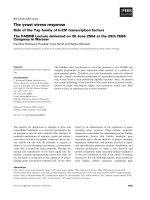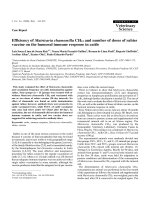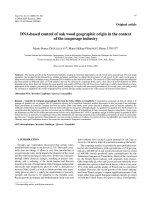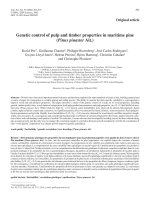DISSECTING THE HORMONAL CONTROL OF THE SALT STRESS RESPONSE IN ARABIDOPSIS ROOTS 1
Bạn đang xem bản rút gọn của tài liệu. Xem và tải ngay bản đầy đủ của tài liệu tại đây (8.11 MB, 102 trang )
!
!
!!
!
!
!
DISSECTING THE HORMONAL CONTROL OF THE
SALT STRESS RESPONSE IN ARABIDOPSIS ROOTS
YU GENG
A THESIS SUBMITTED FOR THE
DEGREE OF DOCTOR OF PHILOSOPHY
DEPARTMENT OF BIOLOGICAL SCIENCES
NATIONAL UNIVERSITY OF SINGAPORE
2013
!
!
!
! !
ACKNOWLEDGEMENT
!
i
!
ACKNOWLEDGEMENT
First I would like to thank my supervisor José R. Dinneny. He is the one who gave me the
opportunity to start this amazing journey. He is also the one giving me lots of help and
support in the past four years. He makes me became a better scientist.
I appreciate Department of Biological Science in National University of Singapore for
allowing me to be a part of the top university in Asia. I appreciate Temasek Life
Sciences Laboratory and Carnegie Institution for Science for their generous financial
support. There is no way I can finish my Ph D training without them.
I would like to thank all the members in Dinneny’s lab for the discussions and help. I am
very lucky to work with these people. I would like to thank people from Yu Hao’s lab in
TLL, people from Wang Zhiyong’s lab in Carnegie, David Ehrhardt and Heather
Cartwright for their valuable advice and help.
Finally, I would like to thank my family and friends for them to understand me, stand by
me no matter what decision I made.
Aug 2013
Geng Yu
TABLE OF CONTENTS
!
ii
!
TABLE OF CONTENTS
ACKNOWLEGEMENT i
TABLE OF CONTENTS ii
SUMMARY vii
LIST OF TABLES ix
LIST OF FIGURES x
LIST OF ABBREVIATIONS AND SYMBOLS xiii
Chapter 1 LITERATURE REVIEW 1
1.1 Introduction 2
1.2 Salt stress in plants 3
1.2.1 Early effects 3
1.2.2 Long term effects 6
1.3 Salt stress signaling in plants 6
1.3.1 CBL-CIPK signaling network 7
1.3.1.1 Salt Overly Sensitive (SOS) pathway 7
1.3.1.2 CBL1/CBL9-CIPK23-AKT1 network and K
+
transportation 9
1.3.2 Osmotic stress signaling 10
1.3.3 The transcriptional programs and phyto-hormones in salt stress response 11
1.3.3.1 ABA biosynthesis and signaling pathways, and its function in salt
stress…………………………………………………………………………… 11
TABLE OF CONTENTS
!
iii
!
1.3.3.2 Jasmonates ( JAs) biosynthesis and signaling pathway and its function in
salt stress 16
1.3.3.3 Ethylene (ET) biosynthesis and signaling pathway and its function in salt
stress 18
1.3.3.4 Gibberellic acid (GA) and Brassinosteriod (BR), two positive growth
regulators and their functions in salt stress 20
1.4 Arabidopsis root development 23
1.5 Cell type specific studies in Arabidopsis roots 25
1.6 Objective and significance of this study 28
Chapter 2 MATERIAL AND METHODS 31
2.1 Plant materials 32
2.2 Plant growth conditions 32
2.3 Live-imaging and data analysis 33
2.4 Sample preparation, RNA isolation, microarray hybridization and data analysis:
Agilent array 33
2.4.1 Protoplasting of roots and isolation of GFP-enriched cell populations by
FACS 35
2.4.2 RNA isolation, microarray hybridization and data analysis: Affymetrix ATH1
arrays 35
2.5 Development of an eFP browser-style visualization tool for the spatiotemporal
map 37
TABLE OF CONTENTS
!
iv
!
2.6 Secondary signaling network construction 37
2.7 Quantitation of ABA content 38
2.8 High-Throughput qRT-PCR 39
2.9 Fluorescence microscopy and image analysis 41
Chapter 3 RESULTS AND DISCUSSION 1 43
3.1 ABSTRACT 44
3.2 INTRODUCTION 44
3.3 RESULTS 48
3.3.1 Growth regulation by salt stress is a multi-phasic process 48
3.3.2 Generation of a spatiotemporal global transcriptional map of the salt-stress
response ……………………………………………………………………………53
3.3.3 Predominant expression patterns highlight both autonomy and coordination in
the stress response of each cell layer 58
3.3.4 A cluster-comparison method identifies secondary hormone signaling events
during salt stress 64
3.3.5 ABA biosynthesis and signaling are dynamically activated during the early
stage of salt stress 67
3.3.6 ABA biosynthesis and signaling promote growth recovery during the late
phases of the salt response……………………………………….……………… 69
3.3.7 Cell-type specific manipulation of ABA signaling highlights the importance of
specific tissues in mediating growth responses to salt stress 72
TABLE OF CONTENTS
!
v
!
3.3.8 Jasmonate activates defense pathways during salt stress and inhibits growth
recovery………………………………………………………………………………74
3.3.9 Dynamic repression of GA and BR signaling during salt stress controls growth
quiescence 77
3.4 DISCUSSION 84
Chapter 4 RESULTS AND DISCUSSION 2 88
4.1 ABSTRACT 89
4.2 INTRODUCTION 90
4.3 RESULTS 93
4.3.1 During salt stress Arabidopsis roots undergo dramatic morphological
changes 93
4.3.2 Ethylene is involved in the morphological changes of the roots during salt
stress 97
4.3.3 Salt promotes cell swelling by elevating ethylene production 102
4.3.3.1 Salt enhances ACSs expression 102
4.3.3.2 The endodermis is crucial for cortical cell swelling by mediating ethylene
production at transcriptional level during salt stress 105
4.3.3.3 Post-transcriptional regulation of ACSs is involved in salt-mediated
cortical cell swelling 110
4.3.4 Salt activates ethylene signaling in the early elongation zone dynamically
during salt stress. 113
4.3.5 Salt-responsive ethylene signaling downstream components show cell-type
specificity in their expression 116
TABLE OF CONTENTS
!
vi
!
4.3.6 Auxin signaling serves as downstream signaling of ethylene in regulating salt-
mediated cell swelling 122
4.3.6.1 Possible functions of auxin transportation in salt-mediated cell
swelling……………………………………………………………………… 123
4.3.6.2 Auxin local synthesis in epidermis of the early elongation zone is
important for salt-mediated cortical cell swelling 127
4.4 DISCUSSION 131
Chapter 5 CONCLUSION 137
REFERENCES 140
SUMMARY
!
vii
!
SUMMARY
Plants have to face a constantly changing environment as they grow in the soil. In order
to survive, growth and signaling need to be dynamically and precisely regulated during
the transition from non-stress conditions to stress conditions. However, little is known
about how the progress through this transition is controlled.
In this study, by using live-imaging, we identified that growth regulation in Arabidopsis
roots during salt stress is a multiphasic process: a brief period of quiescence was induced,
followed by recovery and homeostasis. In order to dissect the transcriptional regulation
behind this phenomenon, we built a high-resolution spatiotemporal transcriptional map
for salt stress using fluorescence-activated cell sorting and microarray-based
transcriptome profiling. By using this map and genetic analysis, we were able to
characterize the key hormonal signaling pathways that are involved in transcriptional and
growth regulation during salt stress and identified the time window and spatial domain of
where they act.
By using confocal microscopy, we found that primary roots undergo drastic cell-type-
specific morphological changes during salt-induced growth quiescence. We focused on
one of these morphological changes, cortical cell swelling, to understand the distinct
functions of different cell types during salt stress. By using genetic and bioinformatic
analyses, we found that ethylene plays an important role in regulating salt-mediated
cortical cell swelling. Salt elevates ethylene production in an endodermis-dependent
manner, and ethylene signaling activates auxin signaling in the epidermis and possibly
triggers cell wall modifications in cortical cells to promote radial expansion.
SUMMARY
!
viii
!
Together, our data reveal a sophisticated assortment of regulatory programs acting
together to coordinate spatially patterned biological changes involved in the immediate
and long-term response to a stressful shift in environment.
LIST OF TABLES
!
ix
!
LIST OF TABLES
Table 1. Accession numbers of analyzed genes and primers used in the Real-time quantitative
PCR analysis. 40
LIST OF FIGURES
!
x
!!
LIST OF FIGURES
!
Figure1. Diagram of Arabidopsis root structure…………………………………… …24
Figure 2. Time-lapse imaging system and semi-automated image analysis…………….50
Figure 3. Salt treatment caused dynamic changes in growth……………………………52
Figure 4. Generation of a spatiotemporal gene expression map of the response……….56
Figure 5. Expression pattern of genes in the spatiotemporal salt response data set with
known tissue-specific expression in roots……………………………………………….57
Figure 6. Spatiotemporal expression patterns observed during the salt response……….61
Figure 7. Fluorol Yellow staining shows an enrichment of suberin deposition during the
salt response…………………………………………………………………………… 63
Figure 8. Analysis of the hormone secondary signaling network regulating salt-
dependent transcriptional programs………………………………………… …………66
Figure 9. ABA biosynthesis and signaling are regulated at the spatiotemporal level
during salt stress……………………………………………………………….……… 68
Figure 10. ABA biosynthesis and signaling are necessary to promote full growth
recovery during salt stress………………………………………………………….…….70
Figure 11. Cell-layer specific ABA signaling controls spatially growth……………… 73
Figure 12. JA may be activated by cell damage at inner tissue layers resulting in
suppression of growth recovery………………………………………………………….76
Figure 13. GA signaling was dynamically regulated during salt stress…………………79
LIST OF FIGURES
!
xi
!
Figure 14. BR signaling is dynamically suppressed during salt stress and is sufficient to
promote early growth recovery……………………………………………………… …82
Figure 15. Model for spatiotemporal dynamics in hormone signaling and growth control
during the salt-stress response………………………………………………………… 87
Figure 16. Arabidopsis roots undergo drastic cell shape changes during salt stress……95
Figure 17. Cell shape change is irreversible due to the rigid plant cell walls…….…… 96
Figure 18. Ethylene is a potent cell shape regulator that may be involved in salt-mediated
cortical cell swelling. ……………………………………………………………………98
Figure 19. Mutations in the genes that are involved in ethylene canonical signaling
pathway impair salt-mediated cortical cell radial expansion but not inhibition of cell
elongation……………………………………………………………………………….100
Figure 20. The expression of ACS2, ACS6, ACS7 and ACS8 is regulated by salt in a
spatiotemporal fashion…………………………………………………………………103
Figure 21. Endodermis is important for salt-mediated cortical cell swelling….………106
Figure 22. Salt responsive ACSs are mis regulated under shr background……………108
Figure 23.!shr defect in salt-mediated cell swelling can be rescued by both exogenous
and endogenous applied ACC………………………………………………………… 109
Figure 24. Post transcriptional regulation may be involved in salt elevating ethylene
production………………………………………………………………………………111
Figure 25. Ethylene signaling is dynamically activated during salt stress…………… 114
LIST OF FIGURES
!
xii
!
Figure 26. Large number of salt-responsive genes are mis-regulated in the ethylene
receptor mutant, etr1-1 background……………………………………………………118
Figure 27. GO analysis of ETR1-dependent salt responsive EIN3 direct target…… 119
Figure 28. Spatiotemporal expression of ETR1-dependent salt responsive genes…….120
Figure 29. Auxin signaling is involved in regulating salt-mediated cortical cell swelling
downstream of ethylene signaling pathway…………………………………………….123
Figure 30. The re-location of PIN2 protein is correlated with cell radial expansion,
AUX1 may promote cell elongation during salt stress…………………………………124
Figure 31. Expression profile of TAA1 gene after salt stress; Cell width phenotype after
salt treatment in taa1 mutants. …………………………………………………………128
Figure 32. The abundance of TAA1 protein starts to increase in the early stage and
becomes stable at later time points of salt stress in epidermis of transition zone…… 130
Figure 33. Model for NaCl promoting cortical cell swelling through ethylene and auxin
signaling pathways…………………………………………………………………… 136
LIST OF ABBREVIATIONS AND SYMBOLS
!
xiii
!
LIST OF ABBREVIATIONS AND SYMBOLS
Chemicals and reagents
ABA
Abscisic Acid
ACC
1-aminocyclopropane-1-carboxylic-acid
AOA
Amino oxyacetic acid
dH2O
Distilled water
EtOH
Ethanol
GA
Gibberellic Acid
BR
Brassinosteroid
MES
2-(N-Morpholino)ethanesulfonic acid
NaCl
Sodium chloride
PAC
Paclobutrazol
Units
°C
Degree celsius
bp
Base pairs
g
gram
hr
Hour
kb
Kilo base-pairs
M
molar
min
minute
ml
Milliliter
mM
Millimolar
nm
Nanometer
nM
Nanomolar
rpm
Revolution per minute
w/v
Weight per volume
µg
Microgram
µl
Microlitre
µm
Micrometer
µM
Micromolar
LIST OF ABBREVIATIONS AND SYMBOLS
!
xiv
!
Others
cDNA
Complementary DNA
COL
Collumella
COR
Cortex
CHIP
Chromatin immunoprecipitation
DNA
Deoxyribonucleic acid
END
Edodermis
EPI
Epidermis
GFP
Green fluorescence protein
LRC
Lateral root cap
PCR
Polymerase chain reaction
Q-PCR
Quantitative PCR
RNA
Ribonucleic acid
mRNA
messenger RNA
RT-PCR
Reverse transcription polymerase chain reaction
SEM
Standard error of mean
STE
Stele
T-DNA
Transfer DNA
!
1!
!
!
!
!
!
!
!
!
!
!
!
!
Chapter 1 LITERATURE REVIEW
!
2!
!
1.1 Introduction
All organisms need to interact with their surroundings to survive. Most of plants are
sessile organisms. Compared to non-sessile organisms, such as most animals, when
facing adverse conditions, plants don’t have many choices but to adapt to them.
Therefore, perception, response and adaptation are fundamental processes that occur in
plants. Most plants are multicellular organisms. Different cell types need to coordinate to
conduct those processes. This makes environment stimuli powerful tools to dissect the
interaction between different cell types in plants.
Salt stress is one of the most severe environmental stresses. More than 6% of the world’s
total land area is contaminated with salt. And this problem is becoming even worse due to
the irrigation or land cleaning (Munns et al., 2008). High salinity has a negative effects
on plant growth and development. Understanding how plants respond to salt is not just an
interesting biological question but also can help us to improve food security by breeding
crops that are more resistant to salt.
Decades of research into the effects of salinity on plant physiology and development and
how plants respond to salt at organ or organism level have generated a wealth of
information. However, our understanding of salt response at cell and tissue levels is still
rudimentary. Due to the simplicity, Arabidopsis roots have been use as a model system to
study cell-type specific responses to salt stress (Dinneny et al., 2008). Based on these
studies, we can clearly see that, at least in Arabidopsis, most salt-stress regulation occurs
in a tissue or cell specific fashion ( Dinneny 2010).
!
3!
!
In this review, we are going to summarize the research progress on salt stress and salt
response in plant, introduce Arabidopsis root structure and development, and discuss how
the cell-type specific analyses in Arabidopsis roots has contributed to our knowledge of
the interactions between cell types.
1.2 Salt stress in plants
The negative effects of high salinity in plant growth are believed to result from water
stress, ion toxicities, ion imbalance or a combination of these factors ( Kurth et al., 1986).
Here we are going to discuss about how salt affects plant growth and development in the
order of when those events occur.
1.2.1 Early effects
The growth of plant cell is determined by the plastic response of the wall to the
mechanical force exerted by the turgor pressure against the cell wall (Kroeger et al.,
2011). So plants need to constantly uptake water from the environment to maintain the
turgor pressure of the cells. High salinity decreases water potential of the soil, therefore
reducing water availability to plants. Here we use salt-induced osmotic stress to refer the
situations where insufficient water availability that is caused by high salinity limits plant
growth and development (Zhu et al., 1997). It has been shown that most early effects of
salt in plant growth are caused by osmotic stress (Munns 2002).
!
4!
!
Salt shock triggers dramatic changes in growth rates. First, the growth is strongly
inhibited just after few minutes of salt treatment, then it recovers gradually in the next 30
mins or more before reaching the plateau (regaining the homeostasis). The time taken to
recover and the growth rates in the new homeostasis stage are salt concentration
dependent. This growth profile is solely driven by the change of water availability, since
when applied with water directly, leaves can grow normally even under salt stress
(Munns et al., 2000).
The rapid and transient reductions in growth rates after salt shock are also observed in
roots. Compared to leaf growth, root growth recovers better after sudden exposure to high
salinity: Maize roots grow slower than growing under normal condition at the early time
points of 150 mM NaCl treatment, while during later time points the initial growth rates
was restored (Rodríguez et al., 1997). Again since other osmotica such as KCl or
mannitol can trigger the similar effects, it is believed that the effects are caused by salt-
induced osmotic stress. It has been shown that the inhibition of cell elongation is due to
plants adjusting water relations in cytoplasm at the expanse of the ability of cell walls to
expand ( Iraki N et al., 1989).
However, other studies also show that supplemental Ca
2+
can alleviate the deleterious
effects of salt stress in cotton root growth (Cramer et al. 1987). Even at 150 mM NaCl,
elongation of sorghum roots was reduced by only 20% if supplemental Ca
2+
was present,
but by 80% if it was not (Colmer et al. 1996). This was believed to result from Na
+
inhibiting Ca
2+
uptake from soil or displacing membrane-bound Ca
2+
(Kurth et al., 1986).
!
5!
!
However, recent studies show that the reason why supplemental Ca
2+
can increase the salt
tolerance is that Ca
2+
can help to keep the balance between K
+
and Na
+
(Luan et al.,
2009).
High concentration of NaCl inhibits K
+
uptake because Na
+
has chemical properties
similar to that of K
+
, so K
+
transporters cannot effectively distinguish Na
+
and K
+
(Rubio
et al., 1995). Consequentially, plants will suffer from K
+
deprivation. Since K
+
is the
cofactor of many essential enzymes, the imbalance between K
+
and Na
+
impairs many
enzymes activity, therefore interrupts many important biological processes, and
eventually affects the final growth output. The imbalance between these two ions
triggers the CBL-CIPK signaling by changing calcium levels in the cytosol, and it will
further interact with and regulate the proteins that involved in the uptake and
translocation of K
+
and Na
+
, maintaining the ‘‘balance’’ of these cations in plants under
stress conditions ( Luan et al., 2009).
High salinity not only inhibits the cell elongation, it can also promote the cell radial
expansion in cotton roots (Kurth E et al., 1986). It is also observed in Arabidopsis
(Burssens et al., 2000). However, the timing of this event was not well characterized in
these studies. We found cortical cells in Arabidopsis roots start to expand radially after 4
hours of 140 mM NaCl treatment (See Chapter 4 Figure 16). And we did not observe a
similar phenomenon after 300 mM mannitol treatment (Data not show). These indicate
cell radial expansion is a salt specific effect.
!
6!
!
In summary, although most of early effects are caused by osmotic stress, there are still
some effects, such as ectopic cell radial expansion, can be the results of ionic stress or the
combination of osmotic and ionic stress.
1.2.2 Long term effects
When salt sensitive plants suffer from high salinity for days, the damages become visible
in older leaves, as observed in white lupin when exposing to 100 mM or higher
concentration of NaCl (Munns et al., 1988). Salt injury is due to salt sensitive plants
lacking the ability of transporting Na
+
, Cl
-
, or both into vacuoles or vacuoles ceasing to
take up incoming salt (Munns et al., 1993). When Na
+
or Cl
-
accumulate in the cytoplasm,
they will inhibit enzyme activity. When they build up in cell walls, the cells will be
dehydrated and eventually killed (Munns & Passioura 1984). As NaCl accumulates
overtime, the older leaves will die. There may not be enough photosynthetic surfaces for
plants to survive.
1.3 Salt stress signaling in plants
Salt stress can trigger the osmotic and ionic stress signaling. Here we will describe the
ionic stress signaling, also known as the CBL-CIPK signaling network, and then we will
present the osmotic stress signaling.
!
7!
!
1.3.1 CBL-CIPK signaling network
As mentioned before, the increase of Na
+
concentration in cytoplasm triggers CBL-CIPK
signaling network by changing free cytosolic Ca
2+
concentration.
1.3.1.1 Salt Overly Sensitive (SOS) pathway
SOS pathway is a part of the CBL-CIPK network. It mainly contains SOS3, SOS2 and
SOS1. They are all identified by forward genetic approach.
SOS3 (CBL4) encodes a myristoylated EF hand calcium-binding protein that works as a
primary calcium sensor to perceive the increase in cytosolic Ca
2+
in plants under salt
stress. The EF hand structure can bind Ca
2+
. The myristoylation at the N-terminus of this
protein is important for its ability to associate with the plasma membrane. It has been
shown that the mutation that abolishes the calcium binding ability leads to increased salt
sensitivity. And the inhibition of myristoylation in wild type plant can mimic sos3 mutant
phenotype, indicating that this lipid modification is important for SOS3 to fulfill its
function during salt stress (Ishitani et al., 2000).
Upon binding to Ca
2+
, SOS3 interacts and activates its downstream component, SOS2
(CIPK24). However, SOS2 is not the only target. It has been shown that SOS3 can
interact with other proteins, such as SOS2-like proteins, to mediate osmotic stress
induction of abscisic acid (ABA) biosynthesis (Zhu 2002).
!
8!
!
CBL10 also function through SOS2. cbl4/cbl10 double mutants show much stronger
phenotype than both of the single mutants and overexpression of CBL10 can partially
rescue the sos3 mutant, indicating that they work redundantly.
Based on GUS reporter expression, CBL4 is mainly expressed in roots. And CBL10 is
mainly expressed in the vasculatures of leaves and shoot tissues. When exposed to 75
mM NaCl, both cbl10 and cbl4 mutants show strong phenotype in both root and rosette
leave growth. However, cbl10 mutants have longer roots than cbl4; cbl4 mutants have
bigger rosette leaves than cbl10. These results suggest that CBL10 mainly works in
shoot tissues and leaves, whereas CBL4 mainly works in roots (Quan et al., 2007).!
CBL10 may have additional functions related to Na
+
sequestration into vacuoles (Kim et
al., 2007).
SOS2 encodes a serine/threonine protein kinase. It has two domains: a kinase domain and
a regulatory domain. The kinase domain is essential for SOS2 to activate downstream
components. The regulatory domain contains a NAF motif (Albrecht et al., 2001) and a
protein phosphatase interaction (PPI) motif. Based on in vitro analysis, the regulatory
domain has an auto-inhibitory function in regulating N-terminal kinase domain. SOS3
and CBL10 activate SOS2 kinase activity by binding to the NAF motif in the regulatory
domain, disabling the inhibitory effect. Phosphorylation is also very important for SOS2
enzyme activity. ABI2 is a PP2C type protein phosphatase. It is a negative regulator of
ABA signaling. It has been reported that ABI2 can bind the PPI motif, dephosphorylate
!
9!
!
SOS2 to deactivate it. This indicates a crosstalk between ABA signaling and SOS2
pathway (Gong et al., 2004)
SOS1 is one of SOS2’s substrates. It is the first locus that identified in SOS pathway. It
is a Na
+
/H
+
antiporter that located in the plasma membrane. It controls ion homeostasis
by transporting Na
+
out of cells and loading Na
+
into xylem vessels (Shi et al., 2002).
Based on the protein structure, it has been predicted that SOS1 may also work as a sensor
to sense Na
+
concentration and form a regulatory loop by regulating and being regulated
by SOS2 (Zhu 2002).
1.3.1.2 CBL1/CBL9-CIPK23-AKT1 network and K
+
transportation
The majority of the salt-induce cell damage is due to ion imbalance between Na
+
and K
+
Therefore, enhancing the K
+
transportation into the cell is as important as pumping Na
+
out of the cytosol. Here we will summarize the research progress on CBL1/CBL9-
CIPK23-AKT1 network and its function in increasing K
+
uptake during salt stress.
CBL1 is involving in regulating salt, cold, osmotic, and even wounding responses. It has
been shown that mutation in CBL1 leads to low tolerance to salt, drought and cold.
Interestingly overexpression of CBL1 can enhance the survival under salt and drought
stress, but lower the tolerance to cold (Cheong et al., 2003). CBL9 works as a negative
regulator of ABA biosynthesis. Mutation in CBL9 leads to hypersensitivity to salt,
drought and ABA, duo to the elevated ABA contents in seedlings (Pandey et al., 2004).









